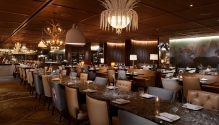Restoring A Maharaja’s Legacy
Sawai Man Mahal in Jaipur is a masterclass in adaptive reuse. It showcases the beauty of Rajputana royal architecture, which has been meticulously restored to offer a sustainable and culturally rich hospitality experience.
By Deepali Nandwani
Sequestered deep in the sprawling 47-acre Rambagh Palace estate
Sequestered deep in the sprawling 47-acre Rambagh Palace estate, Sawai Man Mahal, Jaipur from IHCL’s Taj luxury palace hotels celebrates the legacy of Maharaja Sawai Man Mahal—buccaneer, diplomat, polo player, and the last ruler of the princely state of Jaipur.
The sandstone-coloured hotel with white fringes and trimmings offers a maudlin experience of Jaipur’s regal past. Ashok S Rathore, Area Director – Operations and General Manager, Rambagh Palace, Jaipur, says “Situated in the heart of Jaipur and adjacent to the 19th century living legacy of Rambagh Palace, Sawai Man Mahal carries with it an illustrious history that spans centuries. Originally a modest four-room pavilion during the reign of Maharaja Sawai Man Singh II, the palace witnessed numerous transformations, evolving from a quiet pavilion into a royal residence that hosted nobility and dignitaries.”
The palace property, much like other Rajasthani palaces, particularly in the former Dhundhar region (of which Jaipur princely state was a part), embraces the architectural elements of Rajputana (bold forms, vibrant colours, and emphasis on courtyards, jaalis and verandahs) and Mughal (symmetry, formal gardens, and intricate ornamentation) styles.

The Premium King Bed has a vintage-style bathroom, and flourishes of Rajputana design elements.
Repurposing the past
Over the years, the four pavilions from the Maharaja’s time had been repurposed into a convention centre to host important gatherings, offering a venue for discourse and assembly. However, the most recent transformation of Sawai Man Mahal is perhaps its most significant. It has been meticulously reimagined as a luxury heritage hotel that offers the comforts of modern hoteliering. Rathore says, “We saw profound importance in preserving not just the architectural grandeur but also the rich cultural heritage that defines Sawai Man Mahal. The decision to restore and transform it into a heritage luxury hotel was driven by its potential to tell the story of Rajasthan’s glorious past, offering guests an experience that is as immersive as indulgent.”</p><p>
Adaptive reuse
The adaptive reuse of Sawai Man Mahal exemplifies a thoughtful approach to revitalising historic buildings. IHCL entrusted the restoration to IDEAS, a Jaipur-based firm known for its sensitive restoration of heritage properties. “IDEAS skilfully integrates state-of-the-art modern amenities, creating a space where historical charm and contemporary convenience coexist,” says Rathore. “This evolution showcases the building's enduring relevance."</p><p>
The key restoration points:
Preservation of historical elements: The restoration prioritised preserving the palace's original architecture, including the entrance, antique cannons, structures, intricate motifs, and design features like pillars and domes, which offer a tangible link to its past. Rathore notes, “From the grand arches and delicate jaali work to ornate interiors, every detail was restored to its former glory.”
Sustainable practices: Sustainability was at the core of the restoration to ensure that the transformation was also environmentally responsible. “Eco-friendly materials were used in the construction process, and energy efficiency was enhanced through innovative solutions like solar panels, rainwater harvesting, and smart thermostats,” says Rathore. “The property minimises its environmental footprint, making the hotel both future-ready and eco-conscious.”
Cultural and historical significance: The project has preserved a vital piece of Jaipur’s cultural and historical heritage, offering guests an authentic experience steeped in history. “In doing so, the project also contributes to Jaipur’s reputation as a hub for cultural tourism,” says Rathore.

Ashok S Rathore, Area Director – Operations and General Manager, Rambagh Palace, Jaipur
We saw profound importance in preserving not just the architectural grandeur but also the rich cultural heritage that defines Sawai Man Mahal. The decision to restore and transform it into a heritage luxury hotel was driven by its potential to tell the story of Rajasthan’s glorious past.
Ashok S Rathore
Area Director-operations & General Manager, Rambagh Palace, Jaipur

The space
Sawai Man Mahal is reached by veering right past the Haathi Darwaza (Elephant Gate) instead of continuing straight towards Rambagh Palace. From the
lobby, the walk to the suites is a stroll through stately gardens as sunlight dapples through ancient trees.
Each of the 51 rooms and suites seamlessly blends indoor comfort with the beauty of the outdoors. French doors open onto a private courtyard, where you can relax in a wicker armchair and soak in nature. On the courtyard walls are niches inset with thikri mirror art—elaborate patterns handmade from stone and glass.
Within, sunlight bounces off the polished white marble floor, illuminating the plush king-size bed draped in fine linens. A vintage writing desk invites you to pen a postcard, work or lose yourself in the pages of a good book. Every detail has been curated to create an atmosphere of refined luxury and effortless relaxation. “The heritage structure was fitted with modern conveniences such as luxurious bedding, high-speed internet, advanced climate control systems, and spa-like bathrooms,” says Rathore. “The use of lustrous white marble ensures the room stays cool during Rajasthan’s hot summers.”
Select suites offer private plunge pools for an exclusive touch of indulgence. Spacious royal bathrooms provide a lavish bathing experience.

Rajasthan, and Jaipur's, design flourishes are everywhere, from embellished ceilings and walls to patterns and motifs across the hotel.
Dining in serenity
The al fresco dining area, La Terazza was conceived as an inside-outside space, centred around nature. The “idea was to craft an experience where guests are continuously engaged with nature, enhancing the sense of openness and tranquility that permeates the palace.”
Within, La Terazza is a vibrant space peppered with ceramic plates on the walls and sunlight streaming in. It spills over into verdant greenery with its outdoor setting and interplay of light, air, and the presence of several peacocks and birds, making dining a pleasure.
La Mesa (The Table) is a multi-cuisine restaurant with Spanish influences, inspired by Maharaja Sawai Man Singh II's time as India's ambassador to Spain. The interiors feature natural elements, terracotta, wrought iron, and warm earthy colours. 1835, a library-themed lounge, is named after the year the foundation of Rambagh Palace was laid and pays homage to Maharani Chandravati and Maharaja Sawai Ram Singh II. “It hosts an extraordinary collection of vintage photographs, the Maharaja’s helmet, and trophies. Additionally, a collection of 120-year-old library books adds a scholarly touch, evoking the intellectual and cultural pursuits of the royal family. These preserved elements serve as living relics of the palace’s history, allowing guests to get a rare glimpse into their private life,” says Rathore.
Challenges in restoring a royal palace
Transforming Sawai Man Mahal from a convention centre into a luxurious heritage hotel presented a unique challenge of “introducing contemporary elements in a way that felt natural within the palace’s historical context and not seeming out of place”, says Rathore. This was achieved through a sensitive design approach that preserved key architectural elements.
Centuries-old trees, courtyards, and gardens posed difficulties due to their defined boundaries and existing layouts which included mature trees and gardens. These were thoughtfully integrated into the design and reimagined in a way that celebrated the existing flora. Courtyards were created around the old trees, and gardens were preserved to provide a nature-filled environment for guests.
Sawai Man Mahal is a beacon of Rajputana hospitality, encapsulating the timeless allure of Jaipur explored through the lens of contemporary luxury. The water fountains, spacious courtyards, breezy gardens, and craftsmanship make Sawai Man Mahal an ideal getaway for sybaritic travellers.

The gilded banquet hall, lit by sparkling chandeliers, is connected by a corridor to the lobby, and features the famous mirror or Aaraish work of Rajasthan.


























